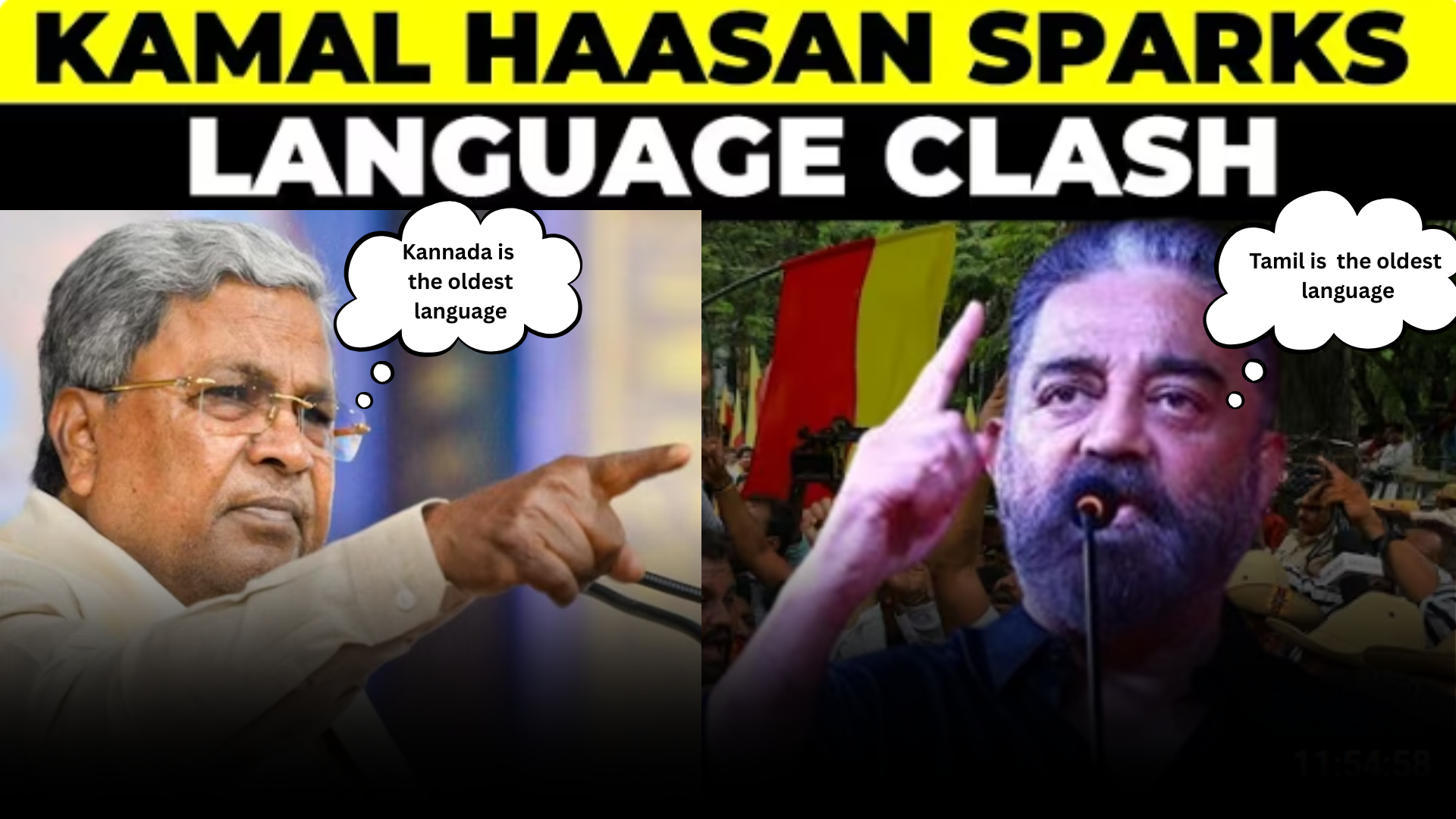Tamil vs. Kannada: Which Language Is Older? A Clear and Engaging Look
Ever wondered which South Indian language Tamil or Kannada has deeper roots? This question excites students, history lovers, and proud locals in Tamil Nadu and Karnataka. Both languages are gems of India’s Dravidian family, and figuring out their age is like piecing together a historical puzzle.
In this article, I’ll explain the latest evidence as of May 2025, dive into recent controversies (including Kamal Haasan’s 2025 remarks), and keep it simple so everyone can follow. Let’s jump in!
What Are Tamil and Kannada?
Tamil and Kannada are Dravidian languages, sharing a common ancestor called Proto-Dravidian, likely spoken about 4,500 years ago. To decide which is older, we look at written records, literature, and archaeological finds. Both have rich histories, but their documented timelines tell the story. Here’s the evidence for each.
Tamil: Strong Evidence for Early Roots
Tamil is often cited as one of India’s oldest languages, and it has solid proof to back it up. Here’s why Tamil stands out:
- Early Inscriptions: Tamil-Brahmi script, found in cave inscriptions in Madurai and Tirunelveli, dates to around 300 BCE. This shows Tamil had a writing system over 2,000 years ago.
- Ancient Literature: The Tolkāppiyam, a Tamil grammar book, dates to the 2nd century BCE, hinting at an even older oral tradition. The Sangam literature, with poems from 300 BCE to 500 CE, highlights Tamil’s vibrant literary culture.
- Recent Discoveries: Excavations at Keeladi near Madurai (2019–2025) found potsherds with Tamil-Brahmi script, possibly from 600 BCE. These dates are under review but could push Tamil’s timeline further back.
- Continuous Use: Tamil’s modern and classical forms are so similar that people today can read ancient texts like Thirukkural.
- Official Recognition: In 2004, India named Tamil a classical language for its ancient, independent literary tradition.
Kannada: A Proud History
Kannada also has a strong historical presence. Here’s what supports its case:
- Early Inscriptions: The oldest Kannada inscription, found at Talagunda, dates to 370 CE, slightly earlier than the Halmidi inscription (450 CE). These confirm Kannada’s written form by the 4th century.
- Literary Works: The Kavirajamarga, a 9th-century CE book on poetics, is Kannada’s first major text, suggesting earlier oral traditions.
- Official Use: Kannada was used in records during the Ganga dynasty (6th century CE) and Rashtrakuta dynasty (9th century CE), showing it was well-established.
Kannada’s written records start later than Tamil’s, but its spoken roots likely trace back to the same Proto-Dravidian era.
Comparing the Evidence: Who’s Older?
Let’s break it down:
- Inscriptions: Tamil’s Tamil-Brahmi (300 BCE, possibly 600 BCE) is older than Kannada’s Talagunda inscription (370 CE).
- Literature: Tamil’s Tolkāppiyam (2nd century BCE) and Sangam poems (300 BCE–500 CE) predate Kannada’s Kavirajamarga (9th century CE).
- Language Continuity: Tamil’s classical and modern forms are closely linked, while Kannada has more regional variations.
- Shared Origins: A 2018 study in Royal Society Open Science estimates the Dravidian family at 4,500 years old, meaning both languages likely existed as spoken forms long ago.
The evidence clearly points to Tamil as the older language based on written records and literature. Still, Kannada’s history is impressive, and both share ancient Dravidian roots.
Debates and Controversies: Why It Gets Heated
This topic isn’t just about facts it’s tied to cultural pride, which can spark lively debates. Here are the key issues fueling the conversation in 2025:
- Keeladi Excavations: The 2019–2025 Keeladi finds suggest Tamil-Brahmi dates to 600 BCE, but some archaeologists question the dating due to incomplete reports. More research could clarify this.
- Kannada Claims: Some argue Kannada is older, citing unverified claims like inscriptions from 1000 BCE or links to ancient Greek texts. These lack evidence and are widely disputed.
- Kamal Haasan’s 2025 Remarks: In May 2025, during the Thug Life audio launch in Chennai, actor Kamal Haasan said, “Kannada was born out of Tamil,” sparking backlash from pro-Kannada groups in Karnataka. They demanded an apology and threatened to boycott his films. Haasan clarified his comment was based on historical linguistics and meant to show love for both languages, as reported by Deccan Herald on May 28, 2025.
- Cultural Pride: Tamil Nadu’s “Pure Tamil” movement emphasizes Tamil’s Dravidian roots, while Karnataka’s pro-Kannada groups defend their language’s heritage. These passions can turn scholarly debates emotional.
- Social Media Buzz: X posts from May 28, 2025, show people debating both sides, with some calling Tamil and Kannada “sister languages” to promote unity.
- Scholarly Questions: A few scholars suggest Tamil’s Sangam literature might be from the 9th century CE, not earlier. Most experts disagree, citing archaeological evidence for earlier dates.
These debates show how much people care about their languages, but they can sometimes cloud the facts.
What’s New in 2025?
Recent developments keep this topic alive:
- Keeladi Progress: Ongoing digs at Keeladi suggest a Tamil civilization as early as 600 BCE, but the dates await confirmation.
- Talagunda Inscription: The 370 CE Kannada inscription at Talagunda extends Kannada’s timeline slightly.
- Kamal Haasan Controversy: Haasan’s May 2025 comment and the resulting backlash have reignited online and offline debates, as seen in X posts and media reports.
- Online Discussions: X posts from May 2025 show fans of both languages sharing facts and opinions, often highlighting their shared Dravidian heritage.
Tamil vs Kannada Which Language Is Older? Look Why This Matters
The Tamil vs. Kannada debate is more than just about age it’s about celebrating two incredible languages that have shaped South India’s culture, literature, and identity. Tamil’s earlier records give it the edge, but Kannada’s contributions are equally valuable. Instead of arguing, we can appreciate how both keep ancient traditions alive.
People also reads : hindi-vs-kannada
Tamil vs Kannada Which Language Is Older? FAQ: Your Questions Answered
Q: Is Tamil older than Kannada?
A: Yes, Tamil’s inscriptions (300 BCE, possibly 600 BCE) and literature (2nd century BCE) are older than Kannada’s (370 CE and 9th century CE).
Q: Could Kannada be older in spoken form?
A: Possibly, as both come from Proto-Dravidian (4,500 years ago), but we lack evidence to prove which was spoken first.
Q: What did Kamal Haasan say in 2025?
A: In May 2025, Haasan said “Kannada was born out of Tamil” at a film event, causing backlash from Kannada groups. He clarified it was a historical comment meant to show unity.
Q: Why is Keeladi controversial?
A: Some question the 600 BCE dating of Tamil-Brahmi potsherds due to unclear methods. A detailed report could settle this.
Q: Are Tamil and Kannada related?
A: Yes, they’re Dravidian languages with a shared ancestor from about 4,500 years ago.



